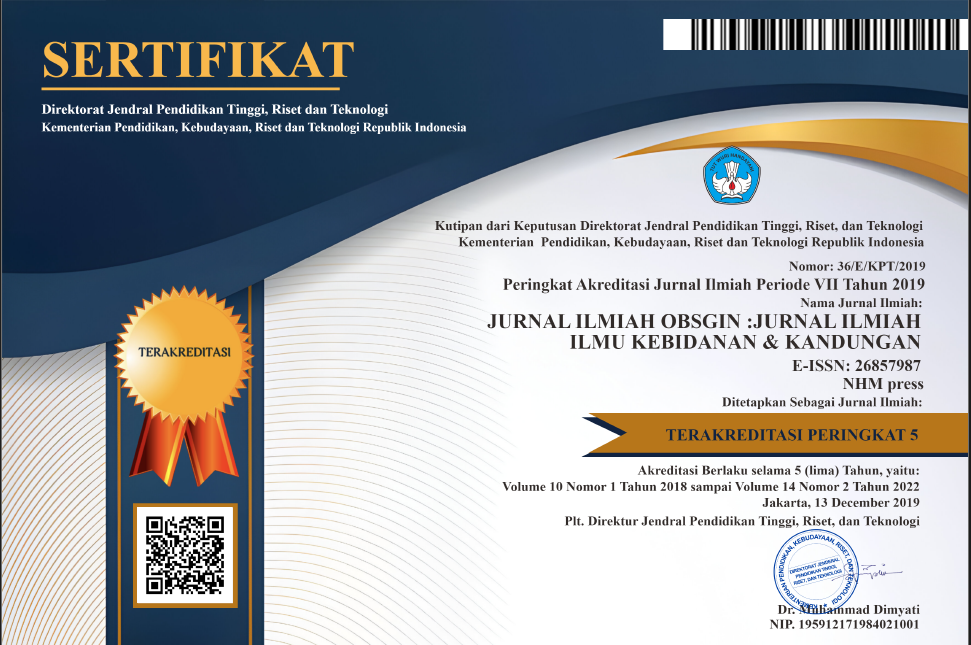HAMBATAN PEMANFAATAN PELAYANAN NIFAS DI WILAYAH KERJA PUSKESMAS X : STUDI KUALITATIF
Abstract
Postpartum period is a critical period for a mother and newborn because long-term health risks occur in this period. Maternal and neonatal deaths mostly occur in the first week after delivery. On the other hand, the postpartum period is a time that is often missed when obtaining quality midwifery services, especially in low and middle income countries. The aim of this research is to determine the barriers to utilizing postpartum services in the Puskesmas X Work Area in 2023. This research is a qualitative research using a phenomenological approach. Five informants were interviewed semi-structuredly, consisting of 1 mother postpartum 1 month, 2 mothers postpartum 2 months, and 2 mothers postpartum 3 months who were selected using purposive sampling technique. Based on the results of the thematic analysis, postpartum mothers have low knowledge about postpartum visits, so awareness about making visits is also lacking. Apart from that, the length of time that must be taken to be checked at a health service facility, inadequate means of transportation to access health service facilities, and not having a supply of expressed breast milk when having to leave the baby at a health service facility are also factors preventing postpartum mothers from making postpartum visits. Apart from that, health workers have not been optimal in providing information regarding the national policy of postpartum visits 4 visits and health workers in the local area have not made home visits. So home visits can be a solution so that midwives can continue to provide education and support to postpartum mothers.
References
Berhe, A., Bayray, A., Berhe, Y., Teklu, A., Desta, A., Araya, T., Zielinski, R., & Roosevelt, L. (2019). Determinants of postnatal care utilization in Tigray, Northern Ethiopia: A community based cross-sectional study. PLoS ONE, 14(8), e0221161. https://doi.org/10.1371/journal.pone.0221161
Girma Tareke, K., Feyissa, G. T., & Kebede, Y. (2022). Exploration of barriers to postnatal care service utilization in Debre Libanos District, Ethiopia: A descriptive qualitative study. Frontiers in Global Women’s Health, 3, 986662. https://doi.org/10.3389/fgwh.2022.986662
Milani, H. S., Amiri, P., Mohseny, M., Abadi, A., Vaziri, S. M., & Vejdani, M. (2017). Postpartum home care and its effects on mothers’ health: A clinical trial. Journal of Research in Medical Sciences : The Official Journal of Isfahan University of Medical Sciences, 22, 96. https://doi.org/10.4103/jrms.JRMS_319_17
Nyondo-Mipando, A. L., Chirwa, M., Kumitawa, A., Salimu, S., Chinkonde, J., Chimuna, T. J., Dohlsten, M., Chikwapulo, B., Senbete, M., Gohar, F., Hailegebriel, T. D., & Jackson, D. (2023). Uptake of, barriers and enablers to the utilization of postnatal care services in Thyolo, Malawi. BMC Pregnancy and Childbirth, 23, 271. https://doi.org/10.1186/s12884-023-05587-5
Probandari, A., Arcita, A., Kothijah, K., & Pamungkasari, E. P. (2017). Barriers to utilization of postnatal care at village level in Klaten district, central Java Province, Indonesia. BMC Health Services Research, 17(1), 541. https://doi.org/10.1186/s12913-017-2490-y
Profil Kesehatan Indonesia 2023. (2024, June 28). https://kemkes.go.id/id/indonesia-health-profile-2023
Sebayang, S. K., Has, E. M. M., Hadisuyatmana, S., Efendi, F., Astutik, E., & Kuswanto, H. (2022). Utilization of Postnatal Care Service in Indonesia and its Association with Women’s Empowerment: An Analysis of 2017 Indonesian Demographic Health Survey Data. Maternal and Child Health Journal, 26(3), 545–555. https://doi.org/10.1007/s10995-021-03324-y
Wojcieszek, A. M., Bonet, M., Portela, A., Althabe, F., Bahl, R., Chowdhary, N., Dua, T., Edmond, K., Gupta, S., Rogers, L. M., Souza, J. P., & Oladapo, O. T. (2023). WHO recommendations on maternal and newborn care for a positive postnatal experience: Strengthening the maternal and newborn care continuum. BMJ Global Health, 8(Suppl 2), e010992. https://doi.org/10.1136/bmjgh-2022-010992
Yonemoto, N., Nagai, S., & Mori, R. (2021). Schedules for home visits in the early postpartum period. The Cochrane Database of Systematic Reviews, 2021(7), CD009326. https://doi.org/10.1002/14651858.CD009326.pub4
Zeleke, L. B., Wondie, A. T., Tibebu, M. A., Alemu, A. A., Tessema, M. T., Shita, N. G., & Khajehei, M. (2021). Postnatal care service utilization and its determinants in East Gojjam Zone, Northwest Ethiopia: A mixed-method study. PLoS ONE, 16(8), e0256176. https://doi.org/10.1371/journal.pone.0256176











